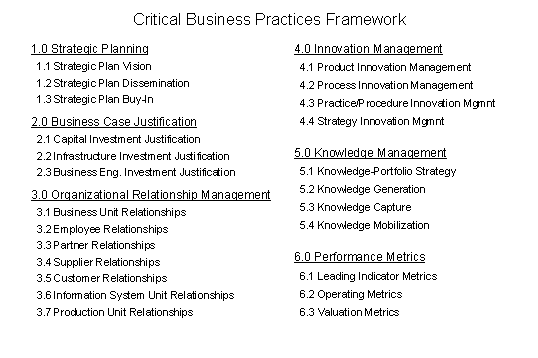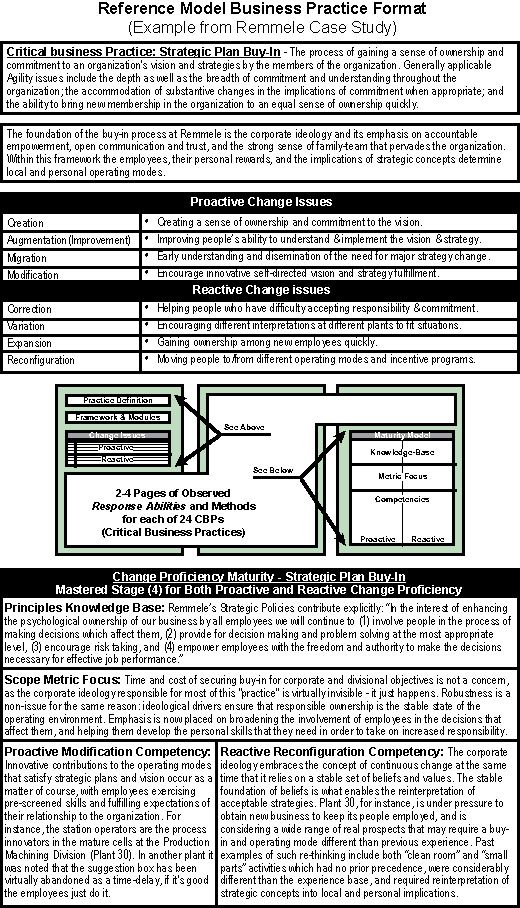 Paradigm Shift
Paradigm ShiftInternational
Agile Enterprise
Reference Model
 Paradigm Shift Paradigm ShiftInternational |
Agile Enterprise |
|
Features: Home | Library |
Corp Info |
(Section A: Part 3 of 4) Twenty-Four Critical Business Practices—The Reference Model Armature Enterprise Agility is not something that happens because technology is put in place, or because machines are configured differently, or even because all business systems are reengineered for reconfigurability. Agile enterprise occurs because of business practices. Business practices are the way we do things and why we do them that way. Explicit practices are codified in our procedures manuals and mission statements; implicit practices are part of the unwritten "system" and culture, and the more powerful because that’s the way things really work. A "short-list" framework of business practices impacting an enterprise’s change proficiency critical in today’s general competitive environment was recently identified. This framework is the result of workshops conducted by the Agility Forum’s '95/'96 Agile Business Practices Focus Group and reflects the realities and concerns in sectors that include electronics, autos/trucks, aerospace/defense, chemicals/process, computers, software, business reengineering, and management consulting. |
 |
The purpose of this framework was to identify those areas that lack sufficient attention, yet are timely and critical in today’s competitive environments. It ignores many competitively necessary and timely practices, such as "listening to the voice of the customer" and "integrated product and process development," that already enjoy high visibility and significant implementation examples. Instead, it illuminates items that meet three specific criteria: 1) they deal specifically with important competitive change proficiency competencies, 2) instances of good implementation and usage are relatively rare and not well understood, and 3) industry in general appears prepared to tackle these elements as a natural next step in its transformation to broader-based change proficiency. This, then, is the frontier of a constantly advancing front. It is what industry is ready to do next, where "industry" is a representative amalgamation of the diverse states of various industry sectors into a single picture. This is not a comprehensive taxonomy of business practices, nor are the category groupings a suggested decomposition of a business model. In the near future one would hope that a different set of practices would be appropriate as the focus moves on to subsequent priorities. Thus, the framework employed here is not timeless, but rather timely: it is both actionable and a necessary next step in general progress today. There are issues about the change proficiency of a given practice, as well as issues about that practice’s ability to support a change-proficient enterprise—both are important, for it is difficult to envision an agile enterprise supported by rigid practices, unless those practices are easily discarded and replaced, which implies an agile practice framework. This reference model project adopted as an armature the critical business practices identified in the ‘95/’96 workshops [4]. As a first application for this framework, the eight-month project effort naturally resulted in some refinement and modification to the original taxonomy, eliminating one redundant practice and strengthening definitions for many others. One of the 24 critical business practices used in the reference model is Strategic Plan Buy-in. Simply deciding to do something different at the top is a long way from getting a massive company to buy-in to that process and actually do something different. For instance: Clearly responding to a market demand created by Sun’s Java and Netscape’s browser, Microsoft's recent rabbit-out-of-a-hat Internet strategy is testament to the ability of a billion-dollar company to turn on a dime. Microsoft accomplished this feat in less than a year. The important difference is in the corporate buy-in process. In any specific industry sector some of these 24 critical business practices are the battleground for competitive position, while others are still uncommonly employed; and the mix is different in different industry sectors. For Microsoft and others in their industry, the practice that routinely achieves strategic plan buy-in appears to be a basic competitive requirement for everyone. In other industries, like metal parts machining for instance, the common requirement for competency at this practice may still be in the future. Of course, a machining company with unique and decided competency at total and rapid buy-in can differentiate itself from all others quite advantageously. The accompanying synopsis description of this buy-in process at Remmele Engineering omits the back-up detail and implementation examples found in the reference model, but it does show the important issues addressed by the practice and an awesome degree of competency. |
 |
Exactly what this competency means to Remmele in its industry sector is a relative question; one which separates practices that are commonly recognized already in a business sector from ones which are still uncommon. The accompanying figure suggests how these two practice classes might characterize a company’s competitive strengths in current and future areas of import. Keep in mind that competency at future differentiating advantages generally translates into preemptive advantage today—something borne out by Remmele’s uncommon performance. |
|
|
|
Features: Home | Library |
Corp Info Send email to |